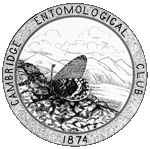
| January 2008: Psyche has a new publisher, Hindawi Publishing, and is accepting submissions |
Article beginning on page 151.
Psyche 5:151, 1888.
Full text (searchable PDF)
Durable link: http://psyche.entclub.org/5/5-151.html
The following unprocessed text is extracted from the PDF file, and is likely to be both incomplete and full of errors. Please consult the PDF file for the complete article.
~anuary i~~g.1 I'S YCHE. 151
year, of an abundance of eggs from difl'erent females, none hatched. Ninety eggs of Sf//- osomft zaii'ma, obtained after a consanguin- eous union failed to hatch. Of Crocallis dar- doharia, which has a single annual brood, the first year 480 eggs, and the second year about PO eggs, all proved fertile, but the third year not an egg hatched out of a large number obtained.
Eucrostis im?igenatct arid Ciu'aria vitiata failed to produce fertile eggs with consan- guineous parents.
He adds : "On the contrary Nemoria aii-
reliaria raised in captivity, has not, during more than ten years, ceased to be fertile, both for spring and fall generations."
'I could multiply these examples, but the facts which I give suffice to show the inter- est which pertains, from the point of view of the establishment of specific characters for lepidoptera, to the verifying that, in each species, the continuance of the reproductive power varies when the pairings are between consanguine~us individuals and without the introduction of new blood.
As Crocallis, Eucrostis, Cidun'n, and
Nemoria all belong to the geometridae, the variability of reproductiveness in close- breeding in a single family ifc very marked. Experiments on such biological subjects need multiplication. G: Dimmock.
PACKARD'S "ENTOMOLOGY FOR
BEGINNERS."
In A. S. Packard's '* Entomology for be- ginners" appears, for the first time from an American publisher, possibly the first time in the English language, a work on general entomology which presents the subject in accordance -with modern scientific progress. Instead of being a systematical classification and enumeration of insects to which the
study of their anatomy, physiology, and
biology is subordinated or appended, as is generally the case with entomological works, the systematic part of this work occupies only about one-third of its pages, and is sprinkled with allusions to habits, and to internal as well as to external anatomy. The great number of species of insects make it necessary to fill a larger proportion of the work with details of classification than would be the case in considering any other division of the animal kingdom. The chapter devoted to "insects injurious and beneficial to agri- culture" is short, but contains as many de- tails, proportionally to the size of the whole book, as seems necessary in a general ento- mological work.
Of special importance and value are the
chapters devoted to modes of collecting, pre- serving, and rearing insects ; to their dissec- tion: and to the cutting and mounting of sections of insects, whole insects, or their organs, for microscopical study. Here Pro- fessor Packard has brought together a good number of methods from widely separated
sources. The directions for dissection and for microscopical research must prove very useful to the younger students in America who
are beginning to turn their attention from unwieldy entomological collections to the comparative anatomy and histology of
insects. At first reading of Professor Pack- ard's work, I was inclined to believe that these methods should have been revised and more thoroughly combined in his work, but a second examination convinced me that the nearer each description retained the words of the originator of the process the better, leav- ing the student or investigator to select for himself the method or pa& of methods best suited to his special requirements.
The list of periodicals and works on ento- mology which occupies ten pages, near the end of the work, is well selected, but there is a lack of uniformity in typographical matters in this list, and in the numerous bibliograph- ical references in the body of the work. Slight inaccuracies of statement are notice- able in places in the work, which is not won- derful when its scope and extent are consid- ered, but it will prove most useful not only to beginners but to all entomologists.
G : Dimmock.
================================================================================
Volume 5 table of contents